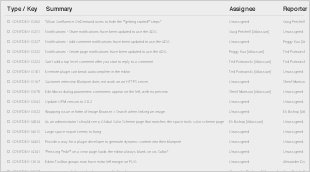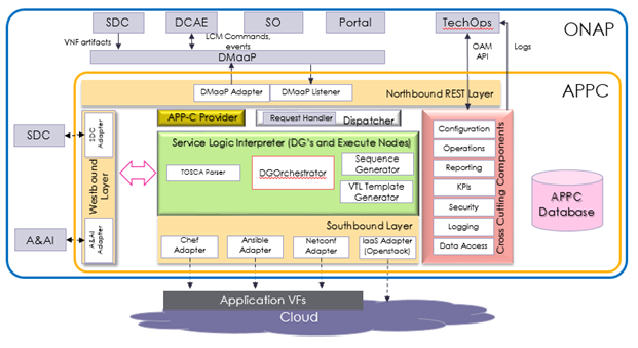Overview
DRAFT PROPOSAL FOR COMMENTS
The content of this template is expected to be fill out for M1 Release Planning Milestone.
Use the "Copy" and "Move" options (available under the ..., top right of this page) to duplicate this template into your project wiki. |
| Project Name | Enter the name of the project |
|---|---|
| Target Release Name | Casablanca Release |
| Project Lifecycle State | Incubation. Refer to ONAP Charter, section 3.3 Project Lifecycle for further information |
| Participating Company | AT&T, Intel (need to confirm), Tech Mahindra, Ericsson |
The Casablanca Release will be focusing on the following areas:
vf-module-id of the vDNS instance that must be added.Describe the use case this release is targeted for (better if reference to customer use case).
The use cases supported in Beijing release will continue to be supported as part of regression assuming all other components do likewise.
APPC will contribute partially to the following use cases as part of the functional requirements.
vf-module-id of the vDNS that was instantiated..Same as was defined for Beijing with the adding of CDT.
List the functionalities that this release is committing to deliver by providing a link to JIRA Epics and Stories. In the JIRA Priority field, specify the priority (either High, Medium, Low). The priority will be used in case de-scoping is required. Don't assign High priority to all functionalities.


The long term road map is to achieve all the goals outlined in the approved project proposal; to be fully model and standards driven, be agnostics and make no assumptions about the network. Support configuration and lifecyle management of VNF/VNFC in a generic fashion so that on-boarding any new VNF/VNFC is just a matter of configuration and data. Longer term items include:
Indicate the outcome (Executable, Source Code, Library, API description, Tool, Documentation, Release Note...) of this release.
| Deliverable Name | Deliverable Description | Deliverable Location |
|---|---|---|
| "App-c Image" Docker Container | Executable | Docker images available on nexus3 |
| Java Source Code | The Java code for the main App-c components. | appc Git repository |
| Deployment Scripts | Linux shell scripts and Maven pom files used to generate the Docker containers. | appc/deployment Git repository |
| Directed Graph Xml Files (DGs) | Xml files define the directed graphs which are installed to database during startup and are used to determine actions taken by app-c | appc/deployment Git repository |
| Yang Model Files | Yang files are used to define the... | appc Git repository |
| Property Files | Property files are used to define values that may need to be changed depending on the environment app-c is run in. | appc Git repository |
| CDT tool | an APP-C Design Tool enabling VNF owners to create templates and other artifacts used by APP-C Configure actions (used to apply a post-instantiation configuration) as well as other life cycle commands | appc/cdt Git repository |
List all sub-components part of this release.
Activities related to sub-components must be in sync with the overall release.
Sub-components are repositories and are consolidated in a single centralized place. Edit the Release Components name for your project in the centralized page.
List the other ONAP projects you depend on.
APPC depends on the the following components as part of the general ONAP architecture:
For the Casablanca release, APPC has dependencies on the following three projects for specific deliverables:
At that stage within the Release, the team is expected to provide more Architecture details describing how the functional modules are interacting.
Indicate where your project fit within the ONAP Archiecture diagram.
Block and sequence diagrams showing relation within the project as well as relation with external components are expected.
Anyone reading this section should have a good understanding of all the interacting modules.
For details on the APPC architecture, refer to the APPC User Guide.

Refering to CII Badging Security Program and Platform Maturity Requirements, fill out the table below by indicating the actual level , the targeted level for the current release and the evidences on how you plan to achieve the targeted level.
| Area | Actual Level | Targeted Level for current Release | How, Evidences | Comments |
|---|---|---|---|---|
| Performance | 0 | 0 |
| |
| Stability | 1 - project team 2 - Integration team Integration team did a 72 hour test in Beijing | 1 - project team 2 - Integration team Assume Integration team will address Level 2 - 72 hour test in Casablanca |
| |
| Resiliency | 2 | 2 In Casablanca we will address Resiliency at the DB level since that was a constrain in Beijing. this will be possible with the move to Maria DB w/Galera |
| |
| Security | 1 | 1? Partial Level 1 definitions in Casablanca where changed. Unclear if we can meet Level 1 at this time based on Open Questions:
|
| |
| Scalability | 1 | 1 |
| |
| Manageability | 1 | 1 Recommendation for Casablanca is Level 2; however, Level 2 requirements are unclear and cannot be committed to. |
| |
| Usability | 1 | 1 Recommendation for Casablanca is Level 2; however, we cannot meeting Level 2 All new API’s must adhere to the ONAP API Common Versioning Strategy and Documentation Guidelines; - There was an issue with ODL & API version - need to investigate further Swagger 2.0 - We dependent on what ODL Oxygen for API documentation and they dictate version of Swagger used, currently looked like v1.2 E2E tutorial ??? |
|
List the API this project is expecting from other projects.
Prior to Release Planning review, Team Leads must agreed on the date by which the API will be fully defined. The API Delivery date must not be later than the release API Freeze date.
Prior to the delivery date, it is a good practice to organize an API review with the API consumers.
API Name
| API Description | API Definition Date | API Delivery date | API Definition link (i.e.swagger) | |
|---|---|---|---|---|
| AAI | REST API | Needs further discussion: New named query to retrieve data for ScaleOut or does APPC need to build the query?? | TBD | |
| CCSDK | OpenDayLight, SLI, AAI Client, dblib | End of June | TBD | |
| DMaaP | API to publish/subscribe to events sent for VNF/VM action requests. | Will DMaaP be providing support for secure topics? | TBD | DMaaP API |
| AAF | Application Authorization Framework | Currently Available | Currently Available |
API this project is delivering to other projects.
API Name
| API Description | API Definition Date | API Delivery date | API Definition link (i.e.swagger) | |
|---|---|---|---|---|
| NB Interface | REST API | Link toward the detailed API description |
Third Party Products mean products that are mandatory to provide services for your components. Development of new functionality in third party product may or not be expected.
List the Third Party Products (OpenStack, ODL, RabbitMQ, ElasticSearch,Crystal Reports, ...).
Name
| Description | Version | |
|---|---|---|
| ODL | OpenDaylight controller platform | Oxygen |
| Docker | Docker container host | 1.12 |
| MariaDB | data base container | TBD |
In case there are specific dependencies (Centos 7 vs Ubuntu 16. Etc.) list them as well.
Provide a description of the testing activities (unit test, functional test, automation,...) that will be performed by the team within the scope of this release.
Describe the plan to integrate and test the release deliverables within the overall ONAP system.
Confirm that resources have been allocated to perform such activities.
This section is used to document a limitation on a functionality or platform support. We are currently aware of this limitation and it will be delivered in a future Release.
List identified release gaps (if any), and its impact.
| Gaps identified | Impact |
|---|---|
| To fill out | To fill out |
Provide a link toward the list of all known project bugs.

List the risks identified for this release along with the plan to prevent the risk to occur (mitigation) and the plan of action in the case the risk would materialized (contingency).
| Risk identified | Mitigation Plan | Contingency Plan |
|---|---|---|
| ODL upgrade to Oxygen & DB to MariaDB - depends on CCSDK projects | CCSDK team has started work early on these two dependencies; They are currently telling us they plant o have these ready at start of Casablanca. | Fall back to Nitrogen & MySQL (same as Beijing) |
| SO dependency to delivery needed data to support the ScaleOut use case - need to provide vf-module-id of the vDNS scaled? | Continue using the flow as designed in Beijing | |
| APPC needs data to be in AAI in order to support the ConfigScaleOut use case for retrieval of the configuration data. Either SDNC (or SO) must write this data into AAI after the instantiation event happens. | Continue using the flow as designed in Beijing | |
| DMaaP support of Secure Topics? |
Fill out the Resources Committed to the Release centralized page.
The milestones are defined at the Release Level and all the supporting project agreed to comply with these dates.
This section is optional and may be used to document internal milestones within a project team or multiple project teams. For instance, in the case the team has made agreement with other team to deliver some artifacts on a certain date that are not in the release milestone, it is erecommended to provide these agreements and dates in this section.
It is not expected to have a detailed project plan.
| Date | Project | Deliverable |
|---|---|---|
| To fill out | To fill out | To fill out |
The Documentation project will provide the Documentation Tool Chain to edit, configure, store and publish all Documentation asset. |
Documentation updates planned for Beijing release are tracked under Documentation Epic: APPC-993
If this project is coming from an existing proprietary codebase, ensure that all proprietary trademarks, logos, product names, etc. have been removed. All ONAP deliverables must comply with this rule and be agnostic of any proprietary symbols.
FOSS activities are critical to the delivery of the whole ONAP initiative. The information may not be fully available at Release Planning, however to avoid late refactoring, it is critical to accomplish this task as early as possible.
List all third party Free and Open Source Software used within the release and provide License type (BSD, MIT, Apache, GNU GPL,... ).
In the case non Apache License are found inform immediately the TSC and the Release Manager and document your reasoning on why you believe we can use a non Apache version 2 license.
Each project must edit its project table available at Project FOSS.
Charter Compliance
The project team comply with the ONAP Charter.